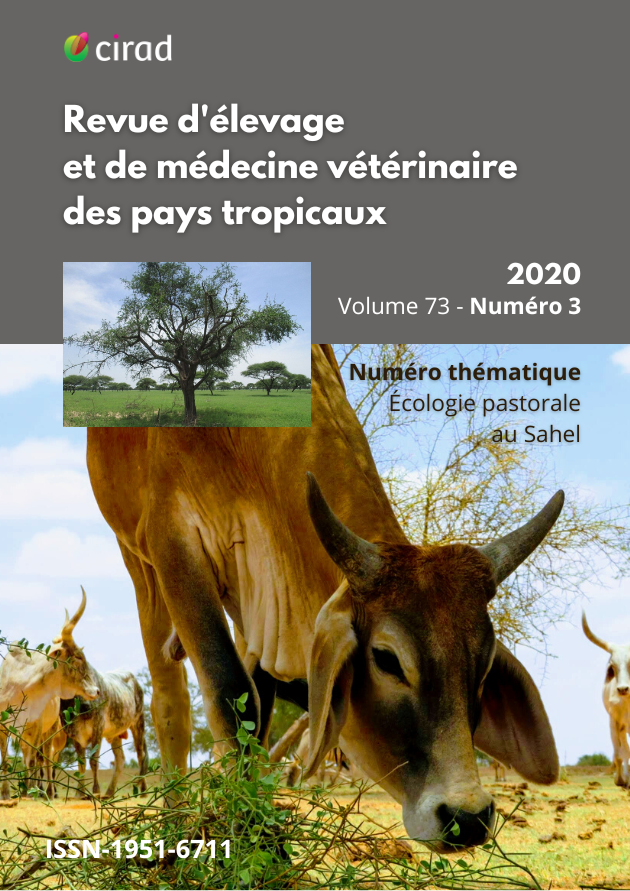Ecologie pastorale au Sahel
DOI:
https://doi.org/10.19182/remvt.36316Resumen
L’élevage de ruminants en Afrique de l’Ouest repose principalement sur des ressources naturelles composées majoritairement de végétation spontanée. Cet élevage pastoral se déroule sur des zones de savanes alliant à la fois des communautés herbacées et ligneuses. L’alimentation du cheptel est fournie pour l’essentiel par le pâturage naturel d’herbacées annuelles complété par celui aérien des ligneux. Cette végétation dépend des précipitations tant sur le plan qualitatif que quantitatif et elle est gérée de manière collective comme un bien commun. En plus de fournir des ressources fourragères pour l’élevage de ruminants, elle rend de nombreux services pour les populations locales comme la production de bois, de produits forestiers non ligneux, de produits médicinaux, ou de services plus globaux comme la régulation du climat. Toutefois, la végétation de ces écosystèmes est soumise à de nombreux facteurs dont, en premier lieu, les variations du climat et de la pluviosité. En effet, les épisodes de sécheresse des années 1970–80 ont fortement impacté la végétation des zones pastorales. Néanmoins, depuis les années 1990, un retour à un régime de pluies plus favorable semble s’amorcer, ce qui induirait un reverdissement du Sahel. Les autres facteurs pouvant influencer la végétation pastorale sont les pratiques d’élevage, la politique d’implantation des forages, l’introduction de moyens et de techniques de développement inadaptés au milieu, les changements d’usage des terres liés à l’agriculture pluviale ou irriguée, l’exploitation des ressources forestières, les feux de brousse, ou encore l’urbanisation ; autant de facteurs qui ont contribué à la dégradation du milieu naturel et à la rupture des équilibres écologiques avec des effets socioéconomiques importants. Les études ciblant cette végétation spontanée permettent de mieux appréhender les dynamiques à l’œuvre et leurs conséquences sur l’élevage des ruminants. C’est dans ce cadre que la Revue d’élevage et de médecine vétérinaire des pays tropicaux et le « Pôle pastoralisme et zones sèches » (PPZS) ont proposé ce numéro thématique sur l’écologie pastorale au Sahel. Ce numéro est introduit par un article de synthèse déclinant les réponses de la végétation aux différents facteurs climatiques et de gestion. Par ailleurs, un article présente un système d’information pour les pasteurs, cinq articles mettent en lumière des cas d’études sur l’impact de la gestion sur la végétation des pâturages dans des situations variées allant de la zone sahélienne du Sénégal à la zone soudanienne du Bénin, et deux articles reviennent sur deux approches en lien avec les sciences humaines et la gestion des espèces et des espaces avec les communautés des éleveurs pastoraux. Ces travaux montrent que les activités d’élevage ont des impacts sur la végétation. Etant le plus souvent communs, les pâturages étudiés sont gérés collectivement à l’échelle d’un territoire où les actions, interactions et rétroactions entre l’influence des activités d’élevage et les modes de décisions de ces activités constituent des facteurs clés pour permettre un développement durable de l’élevage au Sahel.
Descargas
Archivos adicionales
-
Resumen655
-
pdf (Français)189
Publicado
Cómo citar
Número
Sección
Categorías
Licencia
© S.Taugourdeau et al., publicado por CIRAD 2021

Esta obra está bajo una licencia internacional Creative Commons Atribución 4.0.








